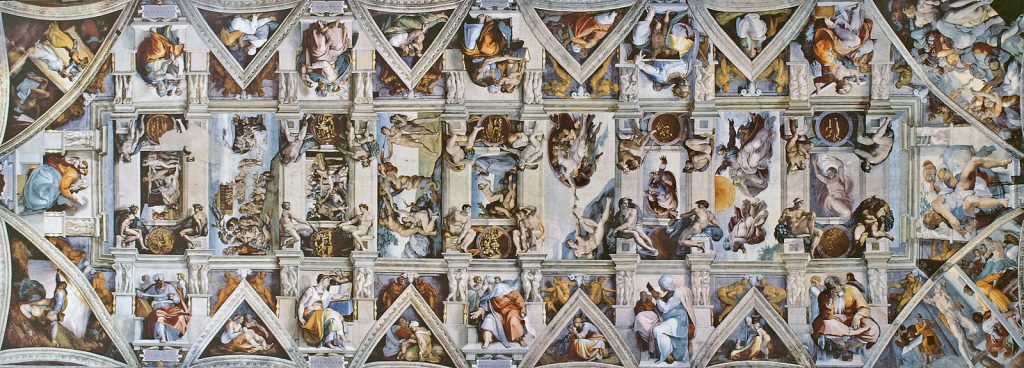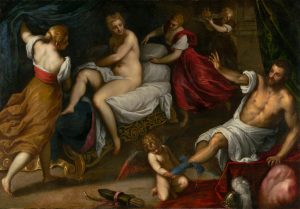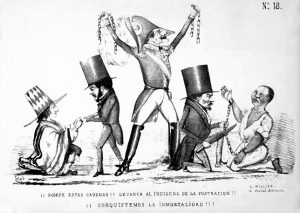From 1508 to 1512, it took Michelangelo five long, torturous years to complete the rigorous task of painting the ceiling of the Sistine Chapel. Spanning more than 10,000 square feet, the iconic piece of high Renaissance art is familiar to many people. Nevertheless, despite Michelangelo’s distinct ability to imply powerful expression and emotion into his art, most people fail to interpret the full story behind the talented artist’s five-year journey. Many may not realize that the beautiful, intricate depictions attributed to Michelangelo were actually painted by an unskilled artist. Likewise, one would not even dare think that the hand behind the brush had minimal interest in painting such marvelous masterpieces.
Michelangelo was by no means recognized as a skilled painter in his time. His fame, rather, came from the sculptures he chiseled in Rome and in Florence in his earlier years. His first sculpture in Rome was Bacchus (1496-1497), which he sculpted for a French ambassador’s barber. The French ambassador then commissioned Angelo to sculpt the Pietà (1498-1499). It was to be Michelangelo’s first contribution to the Catholic Church. The sculpture depicted the Virgin Mary holding the dead body of Jesus Christ. It was widely admired for the pure and simple expression of Mary and the holy serenity of Jesus even in the stillness of death. A few projects later, Angelo worked in Florence, sculpting the massive statue of the biblical hero David. The sculpture David (1501-1504) left Florentine citizens and artists, such as Leonardo Da Vinci, in awe. Eventually, he was assigned to work with Da Vinci painting war cartoons on the walls of the great municipal hall of Florence, known as the Palazzo Vecchio. After treating Da Vinci with severe discourtesy, he was summoned to Rome, by Pope Julius II for a new commission in 1505.1

Upon arriving in Rome, Michelangelo was employed to work on a mausoleum, or sepulcher, for the pope. Julius desired a tomb spanning eight hundred square feet, three stories high, and adorned with twenty six statues. He was willing to pay Michelangelo more than two hundred thousand crowns to complete the grand project. However, the pope’s desires were too extravagant and the expense was absurdly high, so the St. Peter’s basilica, where he desired his tomb to lay, would not allow it. Julius II and Angelo had developed an intimate friendship at this point, as they shared a proud, willful, and honest character. It was tough love between them; they always found a way to reconcile after constant quarreling and the loss of each others’ trust. Suddenly, however, after being denied his mausoleum, the pope’s demeanor changed and he excluded Angelo from the Vatican.2 Donato Bramante, a papal Italian architect, instigated this trouble by warning the pope of the evil omen he invited by constructing his death monument during his lifetime. Jealous of Angelo’s illustrious talent, Bramante encouraged Julius to hire Michelangelo to paint the ceiling of the Sistine Chapel instead, hoping that he would fail miserably. Meanwhile, triggered by his banishment, Michelangelo decided to abandon the pope and return to Florence.3
Three years later, in 1508, after multiple attempts by the pope to forcibly return the skilled artists to Rome, Michelangelo finally met with him. The pope hired him to paint frescoes of the twelve Apostles on the Sistine Chapel ceiling, but Angelo hesitated, knowing that he had inadequate practice with fresco-painting. Nonetheless, Julius repeatedly urged Angelo to accept the job, until finally, Angelo reluctantly gave consent under one condition.4 Michelangelo asked that something more tasteful be painted on the ceiling; he wanted to be allowed to “do as he pleases.” He suggested nine scenes from the book of Genesis, beginning with the creation of the world and ending with Noah and the flood.5

The pope granted his request, and Michelangelo started right away. Bramante was given the task of constructing the scaffolding, but his approach was inefficient and it made holes in the ceiling. This angered Angelo so much that he got the pope’s permission to banish Bramante, and he make the scaffold himself. After making a better scaffold structure, Michelangelo still doubted his abilities for the task, so he summoned his childhood friend, Francesco Granacci, to aid him in preparing designs for the frescoes. Angelo got the hang of it quickly, and soon enough, Granacci and two other assistants were painting over the master’s chalk outlines. Michelangelo’s arrogance engulfed him though, and he regretted inviting his three assistants, who could not express the art in harmony with his detailed ideas. He sent his friends back to Florence and set forth on the project alone, where he spent most of his days alone in the sombre space between the platform and the ceiling. Michelangelo became frustrated; he ached daily from having his head thrown back, spine arched downward, and face covered in paint. Matters only got worse as the winter neared.6
From May until the first winter, nearly one third of the ceiling was complete, but it was all ruined by mold that developed under the perfect conditions of the cold weather and moisture in the Roman lime Michelangelo used to make the plaster. Devastated, Angelo gave up, and shouted to the pope, “I told you I was no fresco-painter; what I have done is ruined.” He took a break from the project for nearly a year, as he waited for favorable weather and for the mold to disappear. It was after this break that Michelangelo’s frescoes underwent an evident change. The paintings became larger and more expressive and emotional. He continued the back-breaking work until it was finally completed in 1512.7
Notably, one well-known fresco that depicts The Creating of Adam, clearly demonstrates Michelangelo’s shift in form and style. The large twisted bodies are very expressive, and the movements portray a strong emotion that can be easily perceived, even from the chapel ground! This style completely contrasts Angelo’s first few frescoes, which were small and complicated. In particular, the scene of The Great Flood is full of action when viewed up close. The fresco contains four stories alone, but they cannot be seen well from the ground. Michelangelo was aware of this issue, but he decided not to feed his frustration and continued painting the ceiling, with the new approach.

Completing the job was not easy for Michelangelo, he had to fight through the strong hatred he developed while painfully painting the frescoes. Some scholars believe that Michelangelo suffered from deconditioning syndrome, which is a state of physical and emotional lethargy as a result of a lack of exercise or movement for long periods of time.8 However, this is due to a common misconception that he worked laying down on the scaffolds, close to the ceiling. In fact, Michelangelo spent hours upon hours with his head bent back, his spine curling in on itself, and his feet aching because he painted standing upright on his designed scaffold. He regretted ever accepting the task; he even wrote a poem in 1509 describing how much he loathed the whole situation:
From the year 1513, when the chapel finally reopened to the public, until the present day, Michelangelo’s arduous accomplishment lives on as a renowned piece of art. The paintings have acquired a low tone due to withering and reckless care, but they still stand to show that he conquered the task and surpassed those who doubted him. Although it may have costed him physical and mental health, his dedication and skill continue to inspire artists and historians, and astonish all those who view his works.10

- Moses Sweetser, Michael Angelo (Michigan: Houghton, Osgood and company, 1878), 23-35. ↵
- Moses Sweetser, Michael Angelo (Michigan: Houghton, Osgood and company, 1878), 34. ↵
- “Michelangelo’s Painting of the Sistine Chapel Ceiling,” ItalianRenaissance.org, May 9, 2013, http://www.italianrenaisance.org. ↵
- Moses Sweetser, Michael Angelo (Michigan: Houghton, Osgood and company, 1878), 48-49. ↵
- “Michelangelo’s Painting of the Sistine Chapel Ceiling,” ItalianRenaissance.org, May 9, 2013, http://www.italianrenaissance.org ↵
- Moses Sweetser, Michael Angelo (Michigan: Houghton, Osgood and company, 1878), 50. ↵
- Andrew Graham-Dixon, Michelangelo and the Sistine Chapel (New York: Skyhouse Pub, 2009), 1-35. ↵
- Raffaella Bianucci et al., “Michelangelo Buonarroti (1475-1564) had the Deconditioning Syndrome While painting the Sistine Chapel Ceiling,” Medical Hypotheses 113, (April 2018): 13-14. ↵
- Gail Mazur, “Michelangelo: To Giovanni Da Pistoia When the Author Was Painting the Vault of the Sistine Chapel,” Poetry 1, no. 1 (2005): https://www.poetryfoundation.org/poems/57328. ↵
- Moses Sweetser, Michael Angelo (Michigan: Houghton, Osgood and company, 1878), 57-58. ↵



120 comments
Cynthia Rodriguez
I studied the paintings in the Sistine Chapel back in my freshman art class in high school. I think it is an incredible piece of work. I think it is strange that Michelangelo was not considered a skill worker during his time. I liked that in the end, the Pope agreed to let Angelo paint what he wished. It allowed for Angelo to truly express himself as an artist. The Sistine Chapel is so big, so it is no surprise to me that Angelo’s body began to ache as he painted. I also had no idea that the 1/3 of the ceiling got ruined by mold. I can only imagine how frustrated Angelo must have been. I think it is amazing that despite that, Angelo finished the job he started, even if it took five years. The paintings in the Sistine chapel are beautiful, I just feel bad that Michelangelo endured so much pain and hatred during the time he painted them. I thought this was a great article, and I enjoyed reading about the behind-the-scenes of the paintings in the Sistine Chapel.
Lyzette Flores
I’ve always heard of Michaelangelo but had never really read a story of his. This one was quite interesting to read. I can’t believe it took Michaelangelo five years to complete his project. It is needless to say that even though it took so long, it came out beautiful. He always felt like he was not good enough or that he was not going to be able to complete it but as many of us have heard: with failure comes success. He was such a talented man and will be remembered for that.
Luisa Ortiz
Jonathan, your title is super clever and the pictures are amazing! Congratulations on being nominated for Best Use of Image for this spring semester! you have many pictures that I enjoyed but for sure my favorite from your article is the the one that is being caption like this: ” Ceiling of the Sistine Chapel, displaying scenes from the Old Testament in chronological order from the main doors to the altar wall (right to left) ” is my dream to one day visit this place, thank you for writing such an amazing article and remember me why I want to visit !
Adrian Cook
Michelangelo’s work could only be done by a true artist as himself. I never knew of these paintings but I was pretty familiar with his sculptures. It’s crazy how someone can spend five years working on a painting and it still be so beautiful to observe. He has done a lot of great work but at a great cost to his body. I wish to visit and see some of these works in person but otherwise a great read and very informative article.
Luis Magana
I really didn’t understand the article based off of the title but once I began reading it I understand better. Ive seen pictures of and heard of some of Michelangelo’s work and I wish I could see it in person. Just the vast presence of such an amazing piece of artwork in front of your eyes would be mesmerizing. He is one of the greatest artist of all times because of his respectful work at the Sistine Chapel. The last image shows how beautiful his work really is.
Christopher Hohman
This was a really cool article. Michelangelo was a terrific painter and it must have been really hard for him to accomplish the masterpiece that was the Sistine Chapel. It is interesting that the pope went back and forth and whether or not he was the right man for the job, and i also think that is cool how much influence the pope had at this time. I also feel that he must have lived a lonely life while he was painting the chapel, that is if it was just him. It also really cool that his masterpiece is still here
Rylie Kieny
This is a great article and one that really interested me as I took an art history class back in high school. Of course I learned about this amazing piece of art but only at face value. I never knew all the facts or the raw details that went into creating such a famous piece of art. It still amazes me he stuck with the project for five long years. I also think it is very interesting that he was mostly known as a sculpture even though his paintings were just as magical. It is also moving that he went through such pain to create pieces of art that would one day be famous globally.
Megan Copeland
I am familiar with Michelangelo’s ceiling painting of the Sistine Chapel in the Vatican. I think it is so crazy that it took him five whole years to complete this painting. If it were me, I know it would have driven me insane! I think this famous piece of art is a great inspiration for up and coming artists because it shows that you can do anything you put your mind to, no matter how long it takes. I have always wanted to see Michelangelo’s painting in person.
Avery Looney
This article was very well written and great read! Michelangelo’s art is absolutely stunning and I could not imagine how beautiful it would be to see in person. I feel like everyone has seen his ceiling painting and “The Creation of Adam” painting. Before reading this I was unaware of how long it took him to complete his work in the Sixtine Chapel. Michelangelo will forever be known as one of the greatest artists of all time.
Angel Torres
Ive learned all about Michelangelo’s work on sculptures due to an art class that I took. The Sistine Chapel came up during the course but we did not get into the details. The article provided and great amount of information behind the painting of the Sistine Chapel. I do not blame Michelangelo for his frustration towards the project, especially due to the conditions in which he had to paint for long periods of time. The poem describing Michelangelo’s frustration shows the reader the emotion viewers don’t see when admiring the Sistine Chapel. Exquisite article.